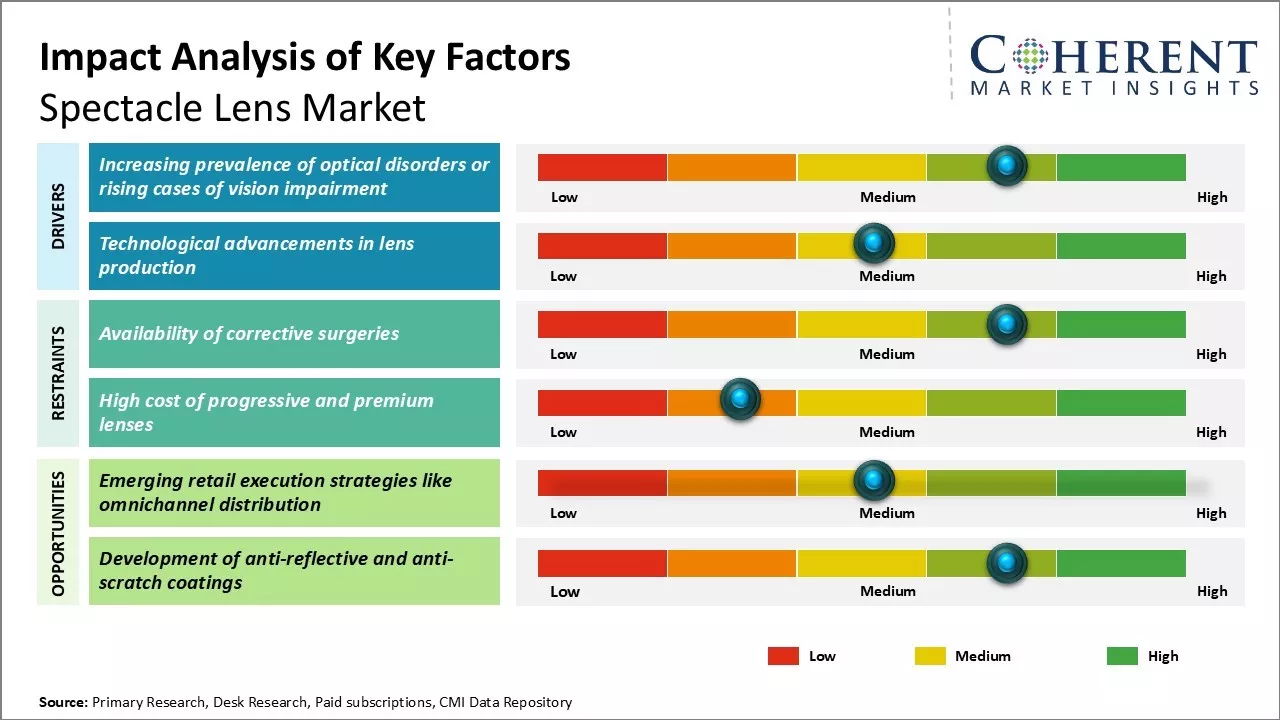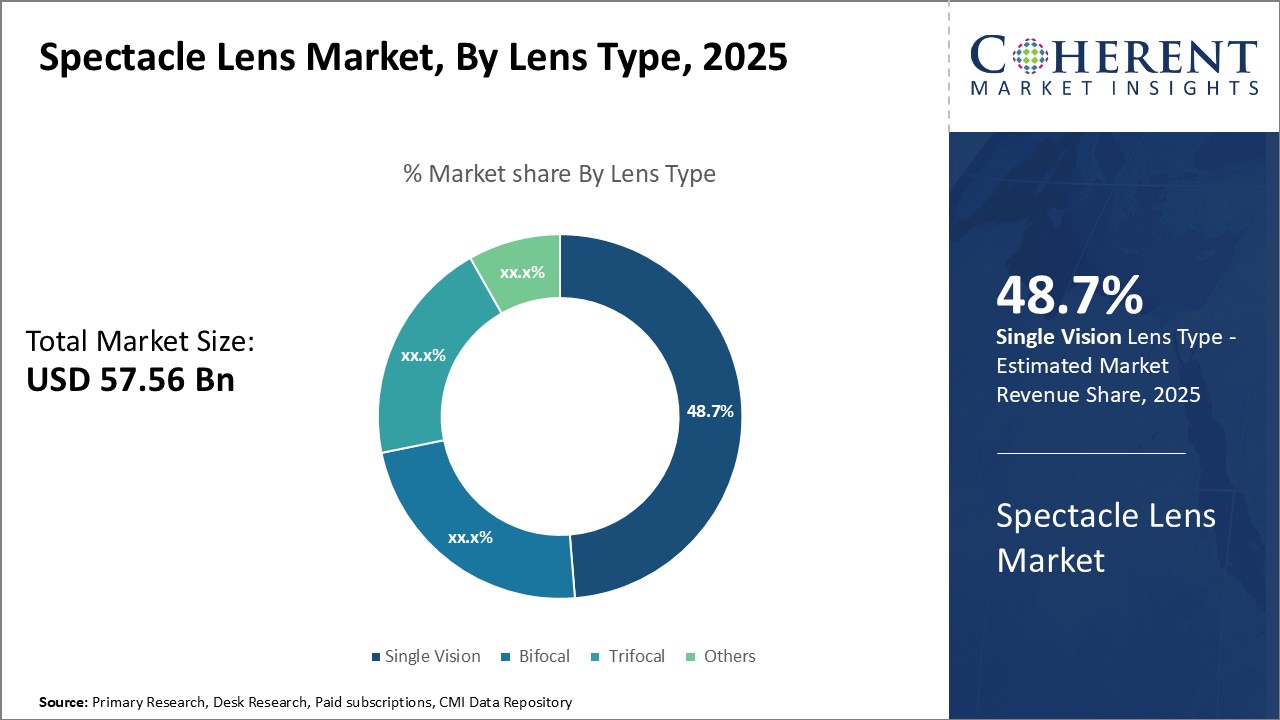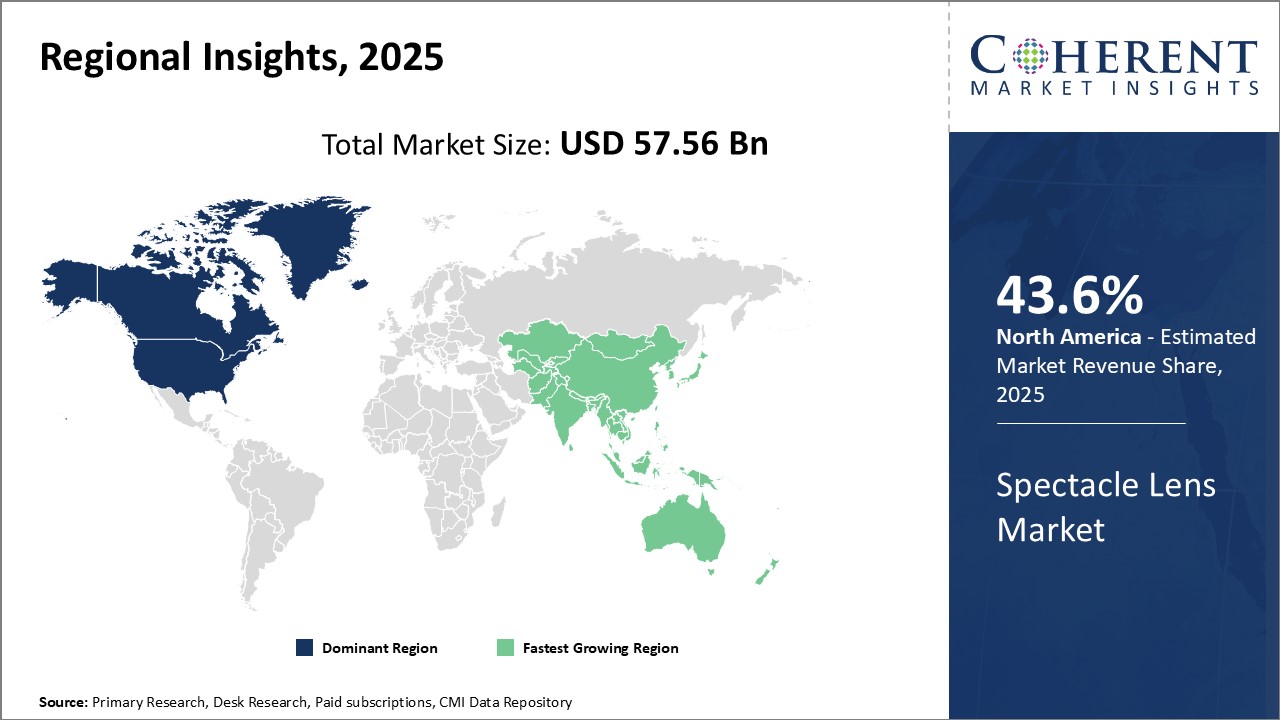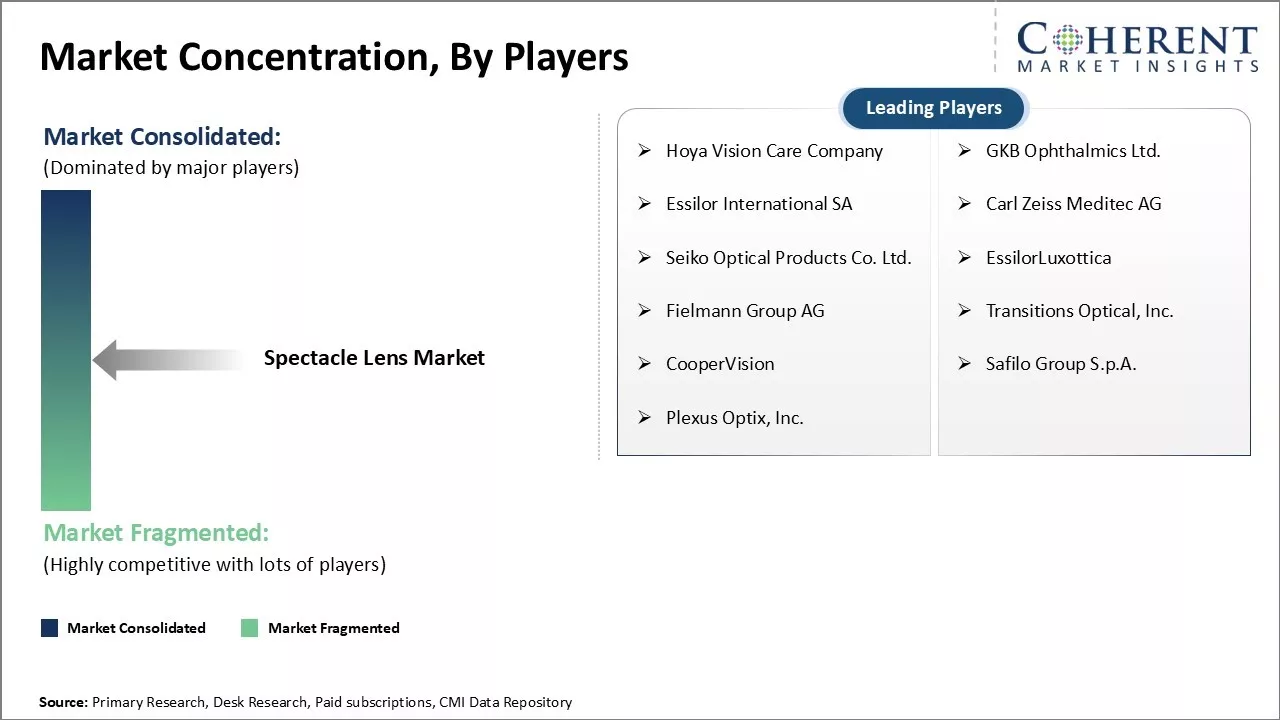Spectacle lens market is estimated to be valued at USD 57.56 Bn in 2025 and is expected to reach USD 78.91 Bn by 2032, exhibiting a compound annual growth rate (CAGR) of 4.6% from 2025 to 2032.

Discover market dynamics shaping the industry: Download Free Sample
Spectacle lens market can witness positive growth over the forecast period due to factors such as rising geriatric population prone to vision impairment, increasing myopia rates globally especially in developing regions and growing adoption of eyeglasses fuel the demand for spectacle lenses. Application of advanced materials and lens treatment technologies enhances visibility, durability and lens performance, further, promoting the uptake of spectacle lenses. However, lack of optometry practitioners in rural areas and availability of vision correction alternatives can hamper the market growth in the near future.

Discover high revenue pocket segments and roadmap to it: Download Free Sample
Insights, By Lens Type- Convenience and basic vision correction boosts demand for single vision lenses
In terms of lens type, single vision segment is estimated to contribute the highest market share of 48.7% in 2025, due to their convenience and effectiveness in addressing basic vision correction needs. These lenses provide a straightforward solution for refractive errors like myopia, hyperopia, and astigmatism, making them ideal for daily activities such as reading and driving. Their affordability compared to multifocal lenses also enhances accessibility, leading to widespread adoption among first-time wearers and those seeking backup options.
Insights, By Coating Type- Rising prevalence of presbyopia boosts demand for anti-reflective coatings
In terms of coating type, anti-reflective coating segment is estimated to contribute the highest market share of 34.4% in 2025, due to growing demand from an aging population suffering from presbyopia. This condition affects nearly everyone over 40 years, necessitating lenses that enhance vision clarity by reducing glare and reflections. Anti-reflective coatings facilitate easier transitions between different focal distances in multifocal lenses, improving user comfort and satisfaction, making them a standard choice for presbyopic lenses.
Insights, By Disease Indication - Increased awareness and diagnosis drives myopia segment
In terms of disease indication, myopia segment is estimated to contribute the highest market share of 54.1% in 2025, due to increased awareness and diagnosis of refractive errors. Myopia, most common refractive error, results in blurred distance vision. Growing recognition of modifiable risk factors has emphasized early diagnosis and intervention, leading to regular eye exams for children and young adults. This trend, alongside heightened screen time during the pandemic, has boosted demand for corrective lenses and treatment options.

Need a Different Region or Segment? Download Free Sample
Dominating Region- North America
North America is expected to dominate the global spectacle lens industry, with an estimated market share of 43.6% in 2025, due to strong consumer demand and presence of major players in the region. Favorable government policies promote vision care services leading to higher adoption rates.
Fastest-Growing Region- Asia Pacific
Asia Pacific region exhibits the fastest growth in global spectacle lens industry, with an estimated market share of 20.2% in 2025, due to growing disposable incomes, increasing health awareness and expanding middle-class population in developing countries such as India and China. Local manufacturers are strengthening their positions in domestic markets through strategic collaborations.
Spectacle Lens Market Outlook for Key Countries
Increasing product launches and rising myopia rates in the U.S.
The U.S. spectacle lens industry is significantly influenced by new product launches, rising myopia rates, and strong emphasis on prescription updates. Key players like Johnson & Johnson Vision and Bausch Health command a substantial share of revenues, reflecting their strategic initiatives and innovations in lens technology to meet increasing consumer demand for effective vision correction solutions. Moreover, there is a heightened awareness of the importance of regular eye examinations and prescription updates, which further fuels the demand for spectacle lenses.
Rising eye care needs in China
China spectacle lens industry is experiencing significant growth due to rising eye care needs of its aging population and promotion of affordable corrective options nationwide. Domestic brands like ALI and MingYue Optical are establishing a strong presence, catering to increasing demand for accessible vision correction solutions as awareness of eye health rises among consumers.
India’s government-private partnerships
India leads the market due to government-private partnerships aimed at enhancing affordability. Key players like Essilor and Titan Eyeplus significantly contribute to this market by offering a range of budget-friendly options. Their efforts help increase accessibility to quality vision correction solutions, catering to a diverse population and promoting eye health awareness nationwide.
Increasing demand for optical products in Japan
Japan spectacle lens market is experiencing growth due to increasing brand consciousness and preference for premium lenses and frames. Consumers are increasingly seeking high-quality optical products that combine functionality with style. Established players like Topcon and Nikon cater to these local trends, offering innovative and premium solutions that meet the evolving demands of discerning customers in the market.

Get actionable strategies to beat competition: Download Free Sample
Top Strategies Followed by Spectacle Lens Market Players
Established Players
R&D Investment- Leading companies like Essilor, Zeiss, and Hoya invest heavily in research and development to introduce innovative products. These employ thousands of engineers and scientists to develop high-performance lenses using cutting-edge materials and advanced manufacturing technologies.
Mid-Level Players
Cost-Effective Solutions- Medium-sized companies focus on delivering quality eyewear at affordable price points to attract cost-conscious consumers. These leverage economies of scale and source raw materials directly to manufacture reliable products at competitive costs. Some players also private-label their designs for retailers.
Small-Scale Players
Niche Specialization- Small manufacturers cater to specialized segments left untapped by larger brands. These develop lenses suited for unique purposes like computer glasses, sports eyewear, or fashion eyewear. This helps gain a foothold by meeting customized needs.
Emerging Startups in the Industry
Innovative Technologies
Examples- Startups like Lenspen and Netra are developing smart lenses integrated with sensors, cameras and AR/VR capabilities. Lenspen is working on future eyewear that can enhance vision, track health vitals and respond to voice commands.
Market/Impact- These advanced technologies could disrupt the spectacle lens industry in the near future. Smart lenses may replace traditional eyewear and enable innovative applications in healthcare, entertainment and more.
Sustainable Solutions
Examples- Eco-friendly startups like Optical Forest focus on utilizing recycled materials from waste streams to create sustainable eyewear collections
Environmental Impact- Such initiatives can significantly lower industry’s carbon footprint and plastic usage over time. This supports global efforts towards developing advanced products in the market.
Key Takeaways from Analyst
Spectacle Lens Market Report Coverage
| Report Coverage | Details | ||
|---|---|---|---|
| Base Year: | 2024 | Market Size in 2025: | USD 57.56 Bn |
| Historical Data for: | 2020 To 2024 | Forecast Period: | 2025 To 2032 |
| Forecast Period 2025 to 2032 CAGR: | 4.6% | 2032 Value Projection: | USD 78.91 Bn |
| Geographies covered: |
|
||
| Segments covered: |
|
||
| Companies covered: |
Hoya Vision Care Company, GKB Ophthalmics Ltd., Essilor International SA, Carl Zeiss Meditec AG, Seiko Optical Products Co. Ltd., EssilorLuxottica, Fielmann Group AG, Transitions Optical, Inc., CooperVision, Safilo Group S.p.A., Plexus Optix, Inc. |
||
| Growth Drivers: |
|
||
| Restraints & Challenges: |
|
||
Uncover macros and micros vetted on 75+ parameters: Get instant access to report
Market Driver- Increasing prevalence of optical disorders or rising cases of vision impairment
The spectacle lens market is driven by the rising prevalence of vision impairment, particularly among the aging population. As life expectancy increases, conditions like myopia, hyperopia, and presbyopia are becoming more common. Myopia has reached epidemic levels among children due to excessive screen time and reduced outdoor activity. By 2050, it is estimated that over half of the global population will experience some form of vision impairment, highlighting the urgent need for corrective lenses to address these growing challenges.
Market Challenge- Availability of corrective surgeries
The spectacle lens market faces significant challenges due to the increasing popularity of corrective surgeries like LASIK and lens implants. These procedures offer a one-time solution for vision issues such as myopia and hypermetropia, reducing the need for glasses or contact lenses. As more consumers opt for these alternatives, market players must raise awareness about the risks of surgeries and position spectacles as a fashionable accessory. Without innovations that enhance the benefits of lenses, market share will continue to decline.
Opportunity- Emerging retail execution strategies like omnichannel distribution
The spectacle lens market is poised for growth through innovative retail strategies, particularly omnichannel distribution. This approach allows consumers to purchase seamlessly across online, mobile, and in-store platforms, catering to their busy lifestyles. Key features like virtual try-on, store locators, and buy-online pickup-in-store enhance convenience. By integrating online and offline capabilities with personalized content, companies can optimize their operations, streamline inventory, and leverage customer data insights to drive market growth effectively.
Share
Share
About Author
Komal Dighe is a Management Consultant with over 8 years of experience in market research and consulting. She excels in managing and delivering high-quality insights and solutions in Health-tech Consulting reports. Her expertise encompasses conducting both primary and secondary research, effectively addressing client requirements, and excelling in market estimation and forecast. Her comprehensive approach ensures that clients receive thorough and accurate analyses, enabling them to make informed decisions and capitalize on market opportunities.
Missing comfort of reading report in your local language? Find your preferred language :
Transform your Strategy with Exclusive Trending Reports :
Frequently Asked Questions
Joining thousands of companies around the world committed to making the Excellent Business Solutions.
View All Our Clients